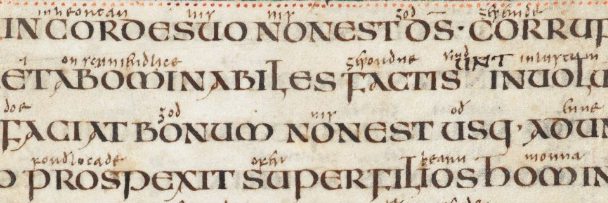Script Type : minuscule
Date : This example of interlinear gloss above the Latin words in uncial script is probably from the early 9th century.
Location : England
Function : book hand






















The script is a fine pointed insular minuscule. Certain letter forms make it tricky to read, apart from the fact that there is hardly a single word that looks like English as we know it. Actually, there is one. See if you can spot it before you pass the cursor over the English words in the picture.
The letters n, u and r are very similar, and s tends to look like what we would interpret as r.
The letter e is tall and open, and it becomes even taller when it appears in ligature in such combinations as en or er. The letter f is broad and extends below the baseline. The letter g has the open, lightning bolt form. The letter d has a backsloping ascender.
The runic letters edh and wen appear, the former for the th sound and the latter for w, which is very similar in appearance to y.
The letters i and j are the same, the latter only appearing here in a Latin proper name.
There are no examples of k, p, q, v, x or z.
To find out more about this fascinating book, and the implications for Anglo-Saxon literacy, proceed to the paleography exercise. The Latin uncial script is examined in a different script example.
The complete text of this work can be found in Kuhn, S.M. (ed.) 1965 The Vespasian Psalter Ann Arbor: University of Michigan Press.
This manuscript is digitised in full on the British Library's website here.
Paleography
exercises for this example using Flash ![]()
Requires at least the Flash 5 plugin
If you are looking at this page without frames, there is more information about medieval writing to be found by going to the home page (framed) or the site map (no frames).